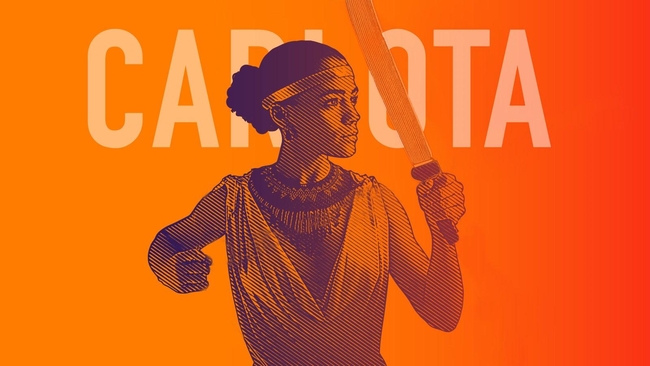Meet Cuba's machete-wielding freedom fighter
Ozy | Friday, 26 October 2018 | Click here for original article

The discovery of the young woman’s corpse on the Triunvirato estate, a sugar mill in Cuba’s Matanzas province, was gruesome, but not surprising. Not only was Triunvirato a property where many enslaved people were housed and maltreated, but the early morning hours of Nov. 6, 1843, when the body was found, followed a night of rebellion. Enslaved people from Cuba’s plantations and sugar mills across Matanzas had risen up against their masters in an organised effort to free themselves. Carlota, an enslaved woman of the Lucumi nation, was among the resistance fighters and one of the movement’s leaders, helping coordinate the rebellion across the region. She was also the warrior whose body was found that November morning.
Most narratives of slave rebellions are told by and about men — they conjure images from Stanley Kubrick’s Spartacus or perhaps Cecil B. DeMille’s The Ten Commandments. These so-called master narratives are hagiographies of White male excellence. Women, and specifically women of colour, do not fit into these accounts because political firebrands and liberation fighters are not roles that sync with society’s traditional notions of femininity. But Carlota was as cunning and resourceful as any of history’s male revolutionaries, and her contributions to the slave rebellion of 1843 should not be underestimated.
Information about Carlota’s background is scant — enslaved people were dehumanised, in part, by erasing their pasts. Historians speculate that she was kidnapped as a child from the region recognised today as the nations of Ghana, Togo, Benin and Nigeria, and forced to endure the brutal middle passage across the Atlantic. It’s impossible to know how often Carlota was bought and sold in the business of the Caribbean slave trade, but experts agree that she played a leadership role in the Triunvirato rebellion by spreading it to the neighboring plantation and gaining the support of other slaves. By the time the uprising was quashed, it had reached five plantations.
"THE TRIUNVIRATO REBELLION SHAPED THE COURSE OF CUBAN HISTORY — AND FIDEL CASTRO’S IDEOLOGY OF THE OPPRESSED RISING UP TO DEFEAT THEIR OPPRESSOR."
The Nov. 5 uprising did not take place in a vacuum, says Aisha Finch, author of Rethinking Slave Rebellion in Cuba. Enslaved people had been resisting in violent and nonviolent ways throughout Cuban history. But increasing numbers of slaves arriving from Africa — over 600,000 were brought to the island in the 19th century, some with military training — combined with harsher conditions of confinement, Finch argues, gave the 1843 revolt a much greater resonance than prior rebellions.
Whether Carlota is viewed as a savage rebel or a freedom fighter, the Triunvirato revolt is ingrained in Cuba’s national consciousness. Its central place in the country’s history, Finch says, is because many see it as a precursor to Fidel Castro’s socialist revolution of 1959. “Leaders of the revolution [in 1959] looked to this moment as a symbol of an ongoing spirit of Cuban resistance,” she says.
And still, Carlota, and other women who joined the resistance, are seldom mentioned in the colonial archives. What hasn’t escaped the archives, however, are testimonials of Carlota’s ferocity and leadership. Witness accounts describe her attacking María de Regla, an overseer’s daughter, with a machete; one fieldworker, Matea Gangá, notes that Carlota bragged about how hard she had struck her victim. De Regla survived Carlota’s attack and later told investigators that as she lay wounded, the “Black woman” had shouted to other slaves that “they should strike her harder because she was still living.”
It’s impossible to say whether this and other accounts of the insurrection were carefully crafted, but it’s also clear that Carlota did not shy away from a fight. And her skills as a combatant were easily matched by her mastery in planning and organising the rebellion. Some sources assert that she used talking drums — hourglass-shaped instruments of West African origin — to communicate with her fellow resistance fighters on the Triunvirato estate and those on the other plantations. The colonists assumed that the drums’ sole purpose was to make music, when instead they were used to spread critical information about the planned uprising.
The Triunvirato rebellion shaped the course of Cuban history — and Castro’s ideology of the oppressed rising up to defeat their oppressor. Today, visitors can tour what remains of the sugar mill and see a towering statue of Carlota, machete in hand. But while she is memorialised in Cuba — the country called its 1974 intervention in Angola to advance its fight for independence “Operacíon Carlota” — she remains virtually unknown in other parts of the world.
Although Carlota’s name is unfamiliar to many, she stands as an embodiment of revolutionary ideals — and a resounding strike against colonial master narratives.
By Jules Franco






